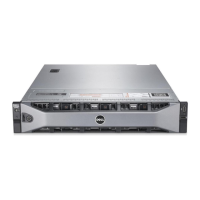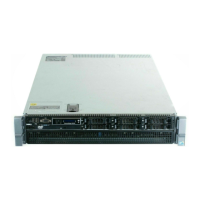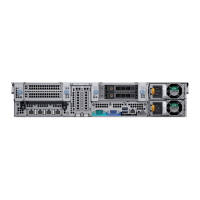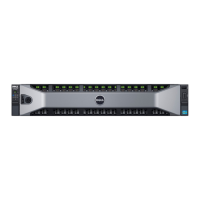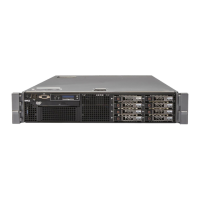Do you have a question about the Dell PowerEdge R860 and is the answer not in the manual?
Describes the front panel components and drive bays of the system.
Details the indicators and buttons on the left control panel.
Explains the indicators and buttons on the right control panel.
Identifies ports, panels, and slots on the rear of the system.
Provides a visual overview of internal components like backplane, CPUs, and DIMMs.
Guides users on how to find the system's unique identification labels.
Describes the location and content of system information labels on the chassis.
Information on compatible rail kits and rack mounting specifications for the system.
Provides the physical dimensions of the server chassis.
Details the weight of the server based on its configuration.
Lists supported processor types and their capabilities.
Details the specifications of the power supply units (PSUs).
Information on the type and specifications of cooling fans used in the system.
Lists the operating systems officially supported by the system.
Provides details about the system's coin cell battery.
Details the specifications and slots for expansion card risers.
Outlines memory types, capacities, and speed supported by the system.
Lists supported internal and external storage controller cards.
Information on supported drive types and configurations.
Details specifications for various system ports and connectors.
Lists supported video resolutions and refresh rates.
Covers operating temperature, humidity, and vibration specifications.
General steps for unpacking, installing, and powering on the system.
Information on configuring the Integrated Dell Remote Access Controller (iDRAC).
Lists resources and documentation for installing supported operating systems.
Explains how to access and use the system setup utility for BIOS and iDRAC settings.
Information on using the Dell Lifecycle Controller for system deployment and management.
Details how to select boot options and diagnostic utilities.
Instructions on using PXE boot for configuring networked systems remotely.
Lists the essential components required for the system to POST.
Explains the system's configuration validation process and error reporting.
Provides critical safety warnings and guidelines for component handling.
Outlines prerequisites and steps to take before opening the system.
Details steps to follow after components have been installed or removed.
Lists the necessary tools for component removal and installation.
Instructions for removing and installing the optional front bezel.
Procedures for removing and installing the system cover.
Step-by-step guide for removing and installing cooling fan assemblies.
Instructions for removing and installing system air shrouds.
Procedures for removing and installing drive blanks and carriers.
Details on removing and installing the 2 x 2.5-inch rear drive module.
Information on supported drive backplane options and removal.
Steps for removing and installing system side wall brackets.
Diagrams illustrating cable routing for different configurations.
Instructions for removing and installing PERC modules.
Guidelines for installing and removing memory modules and population rules.
Information on expansion card slots, risers, and installation guidelines.
Procedures for removing and installing the processor and heat sink module.
Steps for removing and installing the Processor Expansion Module (PEM).
Instructions for removing and installing the PEM power board.
Steps for removing and installing the optional serial COM port.
Procedures for removing and installing the optional VGA port.
Guides for removing and installing BOSS-N1 module blanks and the module itself.
Instructions for replacing the system battery.
Steps for removing and installing the optional internal USB card.
Procedures for removing and installing the intrusion switch module.
Instructions for removing and installing the optional OCP card.
Details on PSU installation, removal, and hot spare feature.
Steps for upgrading and installing the Trusted Platform Module (TPM).
Procedures for removing and installing the system board.
Instructions for removing and installing the LOM card and rear I/O board.
Procedures for removing and installing the right and left control panels.
Details on the BOSS-N1 module kit components and installation.
Information regarding the internal USB card kit and its installation.
Identifies and describes jumpers and connectors on the system board.
Explains the settings and functions of system board jumpers.
Provides steps to disable or reset system and setup passwords via jumper.
Explains the status codes indicated by the power button LED.
Describes the meaning of status LED indicators and corrective actions.
Details system health and ID indicator states and their meanings.
Explains the indicator codes for the iDRAC Quick Sync 2 feature.
Describes the LED indicator codes for iDRAC Direct port activity.
Information on the LCD panel features, status, and error messages.
Explains the link and activity status indicators for the NIC ports.
Details the status indicator codes for AC and DC power supply units (PSUs).
Explains the LED indicators on the drive carrier for drive status.
Guides users on how to run system diagnostics for troubleshooting.
Information on Dell Embedded System Diagnostics (ePSA) and how to run it.
Information on product recycling and end-of-life services.
Steps and methods for contacting Dell support for assistance.
How to use the Quick Resource Locator (QRL) for system information.
Benefits of using Dell Secure Connect Gateway for automated support.
Links to documentation for installing and securing the system.
Links to documentation for iDRAC features and remote management.
Links to Dell OpenManage documentation for system management software.
Links to documentation for RAID controllers and storage cards.
Links to resources for understanding system firmware and agent messages.
Links to the Server Troubleshooting Guide for issue resolution.
Describes the front panel components and drive bays of the system.
Details the indicators and buttons on the left control panel.
Explains the indicators and buttons on the right control panel.
Identifies ports, panels, and slots on the rear of the system.
Provides a visual overview of internal components like backplane, CPUs, and DIMMs.
Guides users on how to find the system's unique identification labels.
Describes the location and content of system information labels on the chassis.
Information on compatible rail kits and rack mounting specifications for the system.
Provides the physical dimensions of the server chassis.
Details the weight of the server based on its configuration.
Lists supported processor types and their capabilities.
Details the specifications of the power supply units (PSUs).
Information on the type and specifications of cooling fans used in the system.
Lists the operating systems officially supported by the system.
Provides details about the system's coin cell battery.
Details the specifications and slots for expansion card risers.
Outlines memory types, capacities, and speed supported by the system.
Lists supported internal and external storage controller cards.
Information on supported drive types and configurations.
Details specifications for various system ports and connectors.
Lists supported video resolutions and refresh rates.
Covers operating temperature, humidity, and vibration specifications.
General steps for unpacking, installing, and powering on the system.
Information on configuring the Integrated Dell Remote Access Controller (iDRAC).
Lists resources and documentation for installing supported operating systems.
Explains how to access and use the system setup utility for BIOS and iDRAC settings.
Information on using the Dell Lifecycle Controller for system deployment and management.
Details how to select boot options and diagnostic utilities.
Instructions on using PXE boot for configuring networked systems remotely.
Lists the essential components required for the system to POST.
Explains the system's configuration validation process and error reporting.
Provides critical safety warnings and guidelines for component handling.
Outlines prerequisites and steps to take before opening the system.
Details steps to follow after components have been installed or removed.
Lists the necessary tools for component removal and installation.
Instructions for removing and installing the optional front bezel.
Procedures for removing and installing the system cover.
Step-by-step guide for removing and installing cooling fan assemblies.
Instructions for removing and installing system air shrouds.
Procedures for removing and installing drive blanks and carriers.
Details on removing and installing the 2 x 2.5-inch rear drive module.
Information on supported drive backplane options and removal.
Steps for removing and installing system side wall brackets.
Diagrams illustrating cable routing for different configurations.
Instructions for removing and installing PERC modules.
Guidelines for installing and removing memory modules and population rules.
Information on expansion card slots, risers, and installation guidelines.
Procedures for removing and installing the processor and heat sink module.
Steps for removing and installing the Processor Expansion Module (PEM).
Instructions for removing and installing the PEM power board.
Steps for removing and installing the optional serial COM port.
Procedures for removing and installing the optional VGA port.
Guides for removing and installing BOSS-N1 module blanks and the module itself.
Instructions for replacing the system battery.
Steps for removing and installing the optional internal USB card.
Procedures for removing and installing the intrusion switch module.
Instructions for removing and installing the optional OCP card.
Details on PSU installation, removal, and hot spare feature.
Steps for upgrading and installing the Trusted Platform Module (TPM).
Procedures for removing and installing the system board.
Instructions for removing and installing the LOM card and rear I/O board.
Procedures for removing and installing the right and left control panels.
Details on the BOSS-N1 module kit components and installation.
Information regarding the internal USB card kit and its installation.
Identifies and describes jumpers and connectors on the system board.
Explains the settings and functions of system board jumpers.
Provides steps to disable or reset system and setup passwords via jumper.
Explains the status codes indicated by the power button LED.
Describes the meaning of status LED indicators and corrective actions.
Details system health and ID indicator states and their meanings.
Explains the indicator codes for the iDRAC Quick Sync 2 feature.
Describes the LED indicator codes for iDRAC Direct port activity.
Information on the LCD panel features, status, and error messages.
Explains the link and activity status indicators for the NIC ports.
Details the status indicator codes for AC and DC power supply units (PSUs).
Explains the LED indicators on the drive carrier for drive status.
Guides users on how to run system diagnostics for troubleshooting.
Information on Dell Embedded System Diagnostics (ePSA) and how to run it.
Information on product recycling and end-of-life services.
Steps and methods for contacting Dell support for assistance.
How to use the Quick Resource Locator (QRL) for system information.
Benefits of using Dell Secure Connect Gateway for automated support.
Links to documentation for installing and securing the system.
Links to documentation for iDRAC features and remote management.
Links to Dell OpenManage documentation for system management software.
Links to documentation for RAID controllers and storage cards.
Links to resources for understanding system firmware and agent messages.
Links to the Server Troubleshooting Guide for issue resolution.
| Form Factor | 2U Rack |
|---|---|
| Memory Slots | 32 DIMM slots |
| Network Options | 1GbE |
| Power Supplies | Redundant power supplies |
| Operating System Support | Red Hat Enterprise Linux, SUSE Linux Enterprise Server, VMware ESXi |
